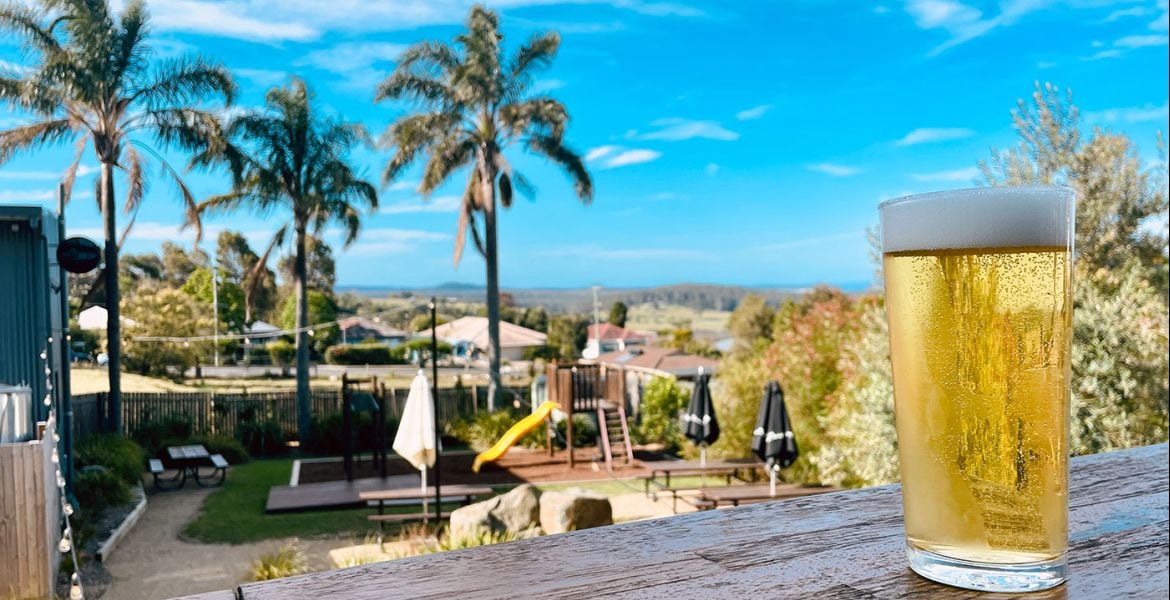The Rimutaka Hill Road is a real bastard. When you look at it on a map, its winding route is like viewing a seismograph at the point when an earthquake hits, the solid line suddenly and rapidly jolting up, down and even back on itself. It’s steep too. When the railway first began running up this way it did so with a rare third rail for extra traction. Even then, on the section with the deceptively gentle name of the Rimutaka Incline, the brake blocks apparently only lasted one trip before being worn down.
As steep, windy and carsick-inducing as it may be, the road is busy. It is the main artery across the Rimutaka Range which separates the populous areas of Hutt Valley and Wellington on the west from the plains of the Wairarapa on the east. Those on the east tend to travel to the cities for work. The westerners make the reverse trip for wine.
The Wairarapa is home to some superb vineyards and wineries. Pinot Noir is the star attraction here, though you will pay handsomely for the pleasure of her company. Most of the vineyards are dotted around the outskirts of the compact and delightfully pretty little town of Martinborough. It is home to less than 2,000 people but that number swells with day trippers from the capital and tourists on the wine trails. It is an easy and orderly place to visit, with a perfect grid stretching out from a central square. And very close to the centre of that square you will find the Martinborough Brewery.
At first glance, it appears little more than a converted cottage, but it is a purpose built structure designed to be in keeping with the town’s cute semi-colonial feel. Between the entrance and the footpath there is a small concrete courtyard with enough room for four tables, plus a couple more around the side. Indoors is not much bigger, but it has a simple modern look that wouldn’t be out of place at a new cafe in Auckland or Sydney. The bar area is almost entirely polished black which has the effect of sending all your attention towards the small circles of colour lined above the taps, each a different beer to try. It all looks slick and new, mainly because it is.
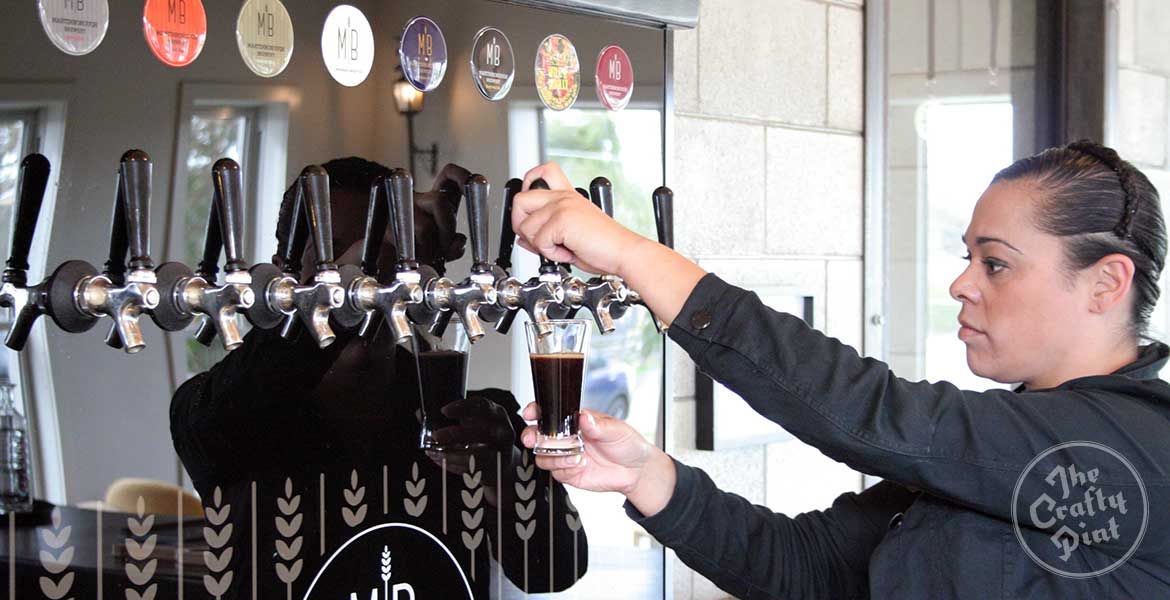
Established by Hayden Frew and Steven Fox, the business was opened at the beginning of 2015 and has been taking its owners by surprise ever since.
“When you set up a business like this,” says Hayden, “you’re basically guessing whether you’ll go through two kegs a week or ten, but it’s gone far better than we thought it would.
“In year one, the tasting room exceeded any expectations in terms of how many people came here and how much beer we shifted across the bar. We’ve been selling a lot of bottles to restaurants and wineries too and that’s just been organic growth; we haven’t pushed it.”
Until recently there wasn’t time to push anything because the pair was working full time in other jobs, Hayden for a timber engineering company (grading timber using, of all things, sound waves), while Steven is a surveyor based in Wellington. The pair would chip away at the brewery business on weekends and in their spare time until it was clear they were juggling too many balls and Hayden made the call to move into brewing full time.
“I’d been in the acoustic timber grading business for ten years,” he says, “and the next growth phase would have involved a lot of international travel. So I sold my shares, which gave some extra money to put into this, and now I’m here full time.
"I’ve been living here in Martinborough for just over nine years so this was a new challenge plus a lifestyle choice.”
Unlike many new brewing companies which begin as a result of a homebrewer making some good beer and deciding to have a crack at the commercial level, the Martinborough Brewery sprouted from a business-before-brewing approach.
“The idea came as an entrepreneurial decision rather than a long held passion for brewing,” says Hayden.
“There are some awesome homebrewers out there but they may not know how to put it into a business. Being a surveyor, Steven is quite analytical whereas I do more of the business side. Because we’d been living here and seeing what was going on in the craft beer industry, we just thought it would work in this town. So we started brewing at my old place, in the shed with a 50 litre kit.
"We did that for about two years, on weekends, doing double batches. We’re both self-taught and we learned on that system.”
Despite the business-first beginnings, this isn’t a brewery focused on insatiable sales targets and perpetual growth. It is a small, hands-on business with an ethos that fits naturally with that of the craft beer community.
“We don’t aspire to be too big,” says Hayden. “We just want to reach a nice size that makes it a sustainable business. We don’t have aspirations of being the next Tuatara or Panhead. We might add a couple more fermenters, but we’re really more of a brewpub.”
While a few years getting their hands dirty in the shed offered an insight into processes and principles, making the leap to commercial brewing wasn’t without its troublesome moments.
“It took a few brews to actually get our heads around what we were doing,” says Hayden, “but we got there.
“The first couple of brews tasted good but didn’t quite come out like we’d planned on the brew sheet, although having the brewpub meant we were still able to bottle them and put them out under names like Accidental Amber. It was really just about understanding efficiencies and understanding how to scale recipes up to the larger brewhouse.”
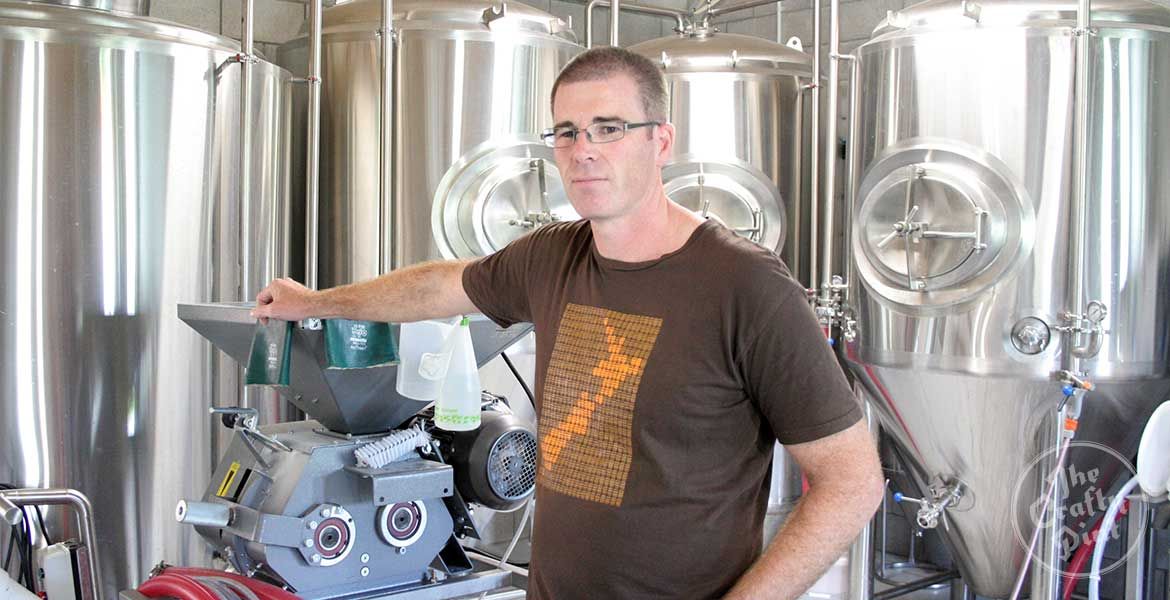
Things are apparently more under control now as their first submission into the Brewers Guild of New Zealand Awards saw a return of three medals, for their mid-strength hybrid Wee Scotch Porter, Black Nectar oatmeal stout and imperial stout. The rest of the regular range includes the single hop Vintage Gold golden ale, Foxy Red and Hop Elixir, an English IPA brewed with New Zealand hops.
“At this stage we’ve kept things pretty traditional,” says Hayden.
“For us the local crowd is really important. They get you through the winter and they usually just want a nice entry level beer that’s a bit different from the mainstream. But we always have a guest beer – if only because it gives me an excuse to visit other breweries!”
[Apparently the entry level criteria doesn’t apply to guest beers: at the time of visiting, Hayden had tapped the Barchen Parchen Friendly Gummy Bear Sour from Wellington’s Wild & Woolly Brewing].
If you find yourself in the Wairarapa and keen to visit more breweries, heading north of Martinborough – while offering a prayer to the gods of limited opening hours – lets you take you in some lesser known options; Regent 58 in Carterton, which has been set up in the town’s old Regent movie theatre, and Peak Brewing which is situated on an organic lifestyle block south of Masterton.
After that, unless you fancy stopping at Dominion Breweries’ Tui brewery, which has been in Mangatainoka since 1889, for a tour (and a recent announcement that jobs would be stripped and production shifted to the company’s larger sites elsewhere in the country means it is likely to be little more than a tourist site), there are no more breweries until you reach the Hawkes Bay.
This is a region blessed with so much, possibly including the fact that because it's not really on the way to anywhere it's not as well visited by domestic travellers as it perhaps ought to be. Instead, the rest of the country simply covets its produce. The land here is incredibly fertile so pretty well anything grows, but, as with the Wairarapa, the most highly regarded prize is grapes. With a similar climate to Bordeaux, vineyards sprawl all over what is the country’s oldest wine region and they produce many of New Zealand’s finest bold reds: Merlot, Cabernet Sauvignon and Syrah.
The region is serviced by the twin centres of Napier and Hastings. The former, with its lone hill and seaside location, is the prettier of the two, though less so when it was razed during an earthquake in 1931 – New Zealand’s worst disaster in terms of lives lost. However, the period after that saw it rebuilt into what remains one of the principal Art Deco cities of the world. If the vast beaches spreading immediately around the city were topped with golden sand rather than pebbles and something resembling ship’s ballast, it’s easy to imagine its compact low rise layout would have long ago been dwarfed beneath a Gold Coast development model.
Hastings, in comparison, is closer to the main agricultural lands to the south and is thus the more industrial and functional hub. There is another smaller enclave, too, that of the well-to-do Havelock North which is nestled at the foot of Te Mata peak, from which you can enjoy magnificent panoramas of the wider bay.
When viewed from a distance, Te Mata has the distinct silhouette of a giant figure sleeping on its back. Māori legend dictates that this is exactly what is it, the giant body of Te Mata O Rongokako who fell here while performing impossible tasks to prove his love for a chieftainess of the local Heretaunga tribe. It is by being and brewing beneath this sleeping giant that Giant Brewing takes its name, which it turns out is also unintentionally ironic.
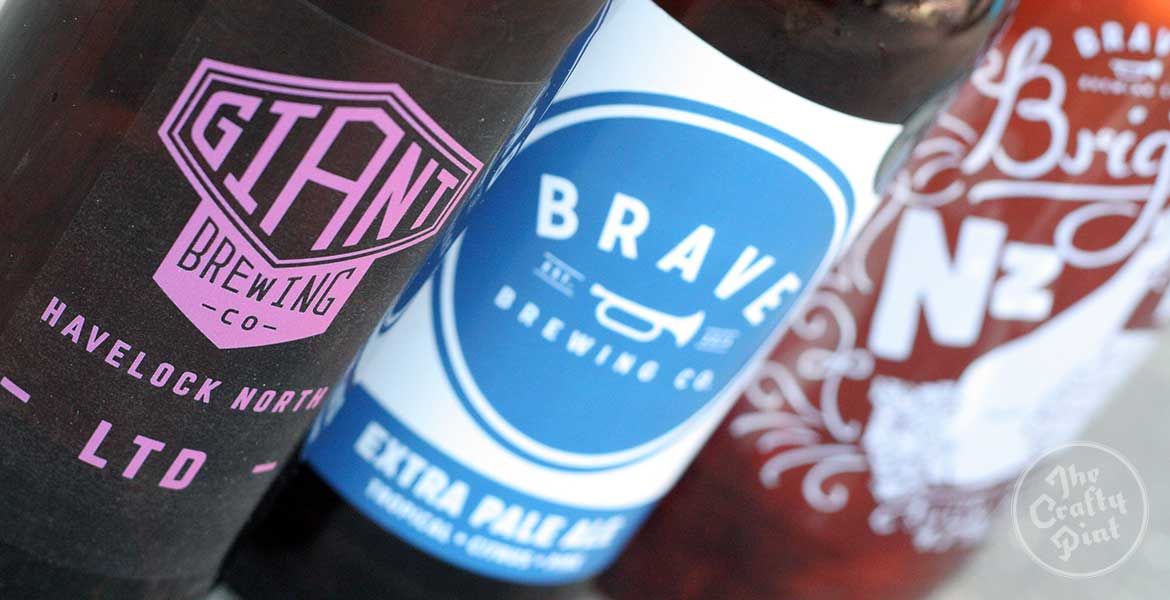
“We’re tiny!” says Chris Ormond of the brewing venture he launched along with his brother Tom and friend George MacKenzie at the end of 2014.
“It started as a kind of hobby business on a 50 litre pilot brewery, just tinkering around doing very small batches and selling to some of the more boutiquey bars in the bay.”
They’d begun that experimentation in a 100-year-old barn on the Havelock Hills, but while that was good for homebrewing it didn’t exactly fit the bill for commercial production.
Indeed, the brewery’s own website paints the scene rather eloquently: “It had great views and acoustics but lacked coving, non-permeable walls and ceilings, adequate waste and hot water systems, a loo, etc”.
Nevertheless, says Chris, they did actually investigate the possibility of doing something there.
“We got a consultant in and he just said, ‘No way, you haven’t got a shit show!’," he says. "Now we lease some floor space in a cheese factory. It’s got the wet floor and all the other stuff that makes the council happy.”
Within six months of launching, their small capacity was somewhere beyond maximum so they began supplementing production by utilising spare tank space at Roosters, one of the local legends of the Hawkes Bay beer scene.
“Ideally, we do want to have a larger brewery and do everything ourselves,” says Chris, “but that’s a pretty expensive leap from being part-nano, part-contract. There’s a lot of craft beer growth in the bay and our beer’s being received well enough, but we haven’t got rock solid ideas about how we’re going to grow.
“I moved here five years ago and had some spare time, so this just became a hobby. Tom has a coffee roasting business supplying bars and restaurants around the bay, and George actually works in Auckland. We all love craft beer and we had the means to pool a little bit of money, but other jobs meant our existence didn’t depend on it. We just had the enthusiasm to do it.”
The range they’re making is naturally limited by their size, but they make full use of every millilitre they brew.
“Making a niche product,” says Chris, “we go for flavour. All the beers have been between 5 and 6 percent [ABV] and have a decent malt or hop profile.”
It began with a New Zealand Pale Ale, then ESB, APA, recently an IPA and, following this year’s hop harvest, there was a beautiful, aromatic but mysterious pale ale.
“A friend of a friend had some wild hops which he’d discovered when we were all homebrewing years ago,” he explains.
“I pulled out some of the roots and planted them at friends' houses and various spots around the Hawkes Bay and in one place it grew particularly well. God knows what kind of hop it is, but it has quite a different aroma and flavour profile. I only had enough to make about 20 cases of beer but I’ll be looking to expand the roots over winter.
“It’s nice to say you’ve got a Hawkes Bay grown hop in your beer. People love local produce here, they get excited when they see real local stuff. I know that when I go to a new place, that’s what I’m looking out for.“
It’s certainly the case in Napier and Havelock North, which are able to draw in tourists with their well established and more upmarket dining and drinking scenes. Slightly different is Hastings where flying the flag of change amid a slightly more institutionalised drinking culture could be seen as a brave more.
Enter Brave Brewing.
Husband and wife Matt and Gemma Smith grew up in the Hawkes Bay but spent the best part of a decade in Auckland. Upon migrating back to the east coast in 2013, they discovered that Auckland’s crippling house prices weren’t quite so debilitating in the bay, affording them the opportunity to start a family home with the added bonus of a large garage.
“I originally intended to do a brewpub,” says Matt, “but I’ve got no hospitality background so the brewery just started there about 18 months ago.”
He comes from a homebrewing background and won the Champion Brewer award at the SOBA New Zealand National Homebrew Competition in the same year the couple moved back to the Hawkes Bay. Now he brews on a 300 litre brewhouse with 1200 litres of fermentation capacity and a couple of bright tanks. As is a common theme with small brewers, he struggles to meet demand.
“About 600 litres a week is about at much as I can manage,” he says. “It's not the most efficient system, especially with the packaging. Even if I brewed more I couldn’t keep up.”
His beers are generally US-inspired, hop forward and aromatic. The flagship by default, which is to say the one people choose to buy the most of rather than what he might necessarily choose to brew, is the Extra Pale Ale, but there is also an American brown ale, Pacific wheat ale and a saison.
“When I was home brewing,” says Matt, “I did a lot of Belgian and sour beers and that’s what I want to do more of, but once I started and got on a few beer lists I didn’t have time. If I do have a spare tank I’ll throw something different out there.”
Ninety percent of Brave’s beer is consumed within the Hawkes Bay which in itself signals a wider change in beer tastes.
“Even since we’ve moved back here it does seem like there’s a lot more beer around,” he says.
“It’s a bit different to bigger cities with lots of beer bars and taps. We don’t have that, which forces us to do a bit more bottling, but there are more people talking about it. Restaurants are making an effort to get involved – our bottles are now at a lot of winery restaurants – although, being a wine region, I actually thought they’d already have been more onto the local stuff. We’re very much about cultivating that local identity. We do our own deliveries and keep an eye on how the beer is being treated.
“We’re in the process of finding a new space but we’ll try and stick to Hastings. It’s got some cool stuff going on and people adding some vibrancy to the area so we want to contribute to that.”
The overall contribution from brewers in the region is growing continuously. Roosters and Hawkes Bay Independent Brewers are two of the larger and more established producers. The new wave is being ridden by the likes of Giant and Brave, the Napier Brewing Company based in Hawkes Bay’s oldest pub, GodsOwn Brewing, which is aiming to be the first hop farm in the North Island, the small and elusive Sneaky Brewing, and Fat Monk with its brewery and cellar door in the Abbey Cellars winery.
Another brewery with a wine connection is the Zeelandt Brewery, pronounced with a Dutch accentuation to be something like "say–land". It is in the Esk Valley on the Napier–Taupo road, the main route back towards the centre of the island, and is large in comparison to many of the other new breweries in the region, though currently that is due to its warehouse footprint rather than outright brewing capacity. It shares land with, and is surrounded by, vines growing aromatic white grape varieties for the Petane Station label. Both are family run businesses, which is to say run by the same family; Zeelandt by Christopher Barber and Petane by his brother, Philip.
The brewery component was launched in 2012, though Chris’ journey into beer that brought him here began some ten years earlier.

“I’d worked at a brewery in Cornwall in the UK,” he says, “then at Hallertau in Auckland, then I went back to Sunderland in the north of England to do a brewing diploma. It took a few years to put this building together, trying to get consent and just chipping away at it in spare time.”
The building itself has been purpose built and it houses one of the more unique looking brewhouses you’ll find locally, its German-built copper vessels procured by way of a brewery that had closed in Japan. With it, Zeelandt produces beers that predominantly stay true to traditional European styles.
“They’re really just the beers I like drinking,” says Chris.
“When I was travelling overseas in early 2000s, through places like Belgium, German and Czech Republic, there were some great flavours and things that were so drinkable which I thought we didn't really have in NZ at the time.”
Zeelandt’s core range thus consists of a German Helles lager, German hopped pilsner, English ESB and a pale ale which is something of an outlier in that it uses new New World hops. The seasonal and limited releases stay true to Chris’ Eurocentric direction in the form of a Kolsch, saison, hefeweizen, schwarzbier, dunkelweizen, Vienna lager and London porter.
“We generally have six beers available at any time,” he says. “We’re now trying to expand the range keeping within traditional styles, but without having too much of a scattered approach.”
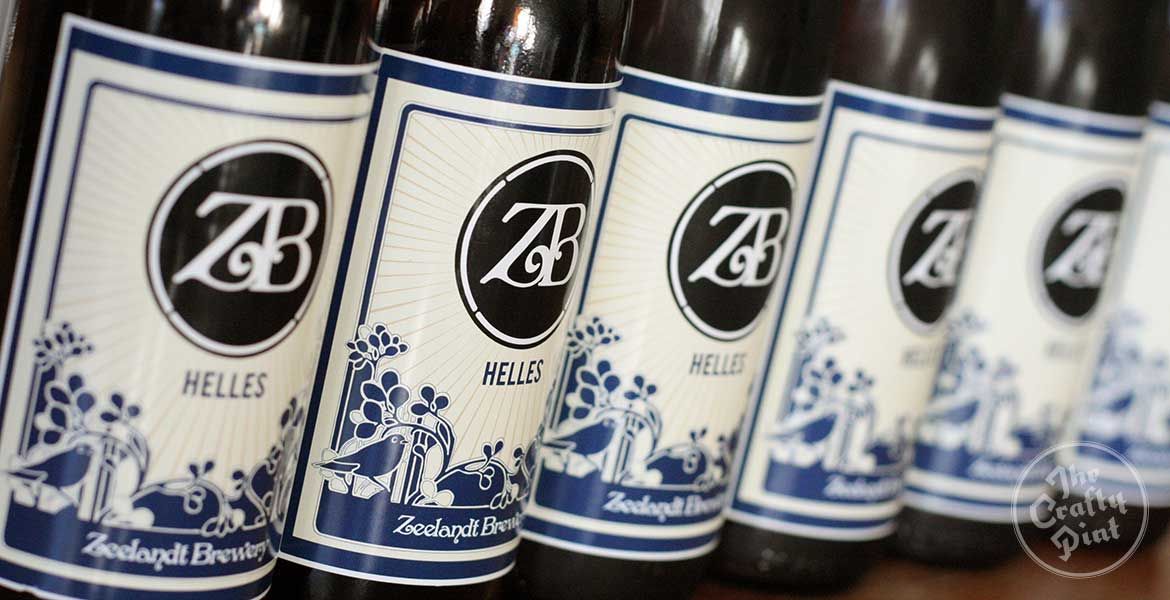
Four years in, and with the brewery gradually increasing its capacity – the three original fermenters having been joined by a larger 2000 litre sibling, it seems the market for what they are making is widening all the time. With capacity to produce enough beer to actively "export" beyond the bay, Chris sees the bigger cities to the northwest, Auckland and Hamilton, as natural places to grow the business rather than focusing too much effort on fighting it out in the established market in the capital.
“Auckland has the growth for craft beer, simply because of the population, and will become the biggest market,” he says. “Wellington has had the big growth so it’s a little tougher to get into.”
Of course, none of the outside growth would be possible if they weren’t supported by their local community. But that support has, at times, been hard won.
“I thought that just by setting up a brewery here the news would spread like wildfire, but it took a lot of work to get the name out there,” says Chris.
“At the start there were a handful of people that would take you on straight away but others were a lot harder work. That’s changed heaps in the last few years and I think having a few breweries open up in Hawkes Bay has helped. When we came on board a beer list here would maybe have Tuatara, now you look at beer lists and there are a lot more local options. That’s helping build awareness that there actually are choices out there other than the mainstream.
“Hawkes Bay still has a lot of work to do. [People drink] a lot of good wine and some shit beer, but people are starting to now embrace it.”
The local beer, that is. Not the shit. And, provided this new crop of brewers continues to ensure local beer and shit beer are not one and the same, Hawkes Bay is a region with all the necessary attributes to develop a formidable beer scene in the coming years.
Driving out of Zeelandt and turning right, there’s little to make you stop for the next 140 kilometres until you abruptly arrive at a T intersection at the edge of Lake Taupo.
This is a remarkably serene place considering it was formed by forces of unimaginable violence. The lake, New Zealand’s largest at more than 40 kilometres in length and 30 in width, is merely a pool that has formed in the crater of what is termed a supervolcano. Although it’s apparently dormant rather than extinct and you wouldn’t want to be anywhere in the nearest hemisphere should it decide to start huffing and puffing, it’s hard to dwell on apocalyptic thoughts when your troubles so easily melt away in the hot pools dotted around the lake’s fringes – a definite upside to all that hydrothermal activity bubbling away beneath the surface.
The township of Taupo, at the northern edge of the lake, is one that relies heavily on tourism. Being in the centre of the North Island, it is a natural place to stop on your way to almost anywhere else. It helps that it’s the kind of place where you can tick off just about every box in the visitor’s guidebook: boating, fishing, rafting, riding, hiking, golfing and attaching oneself to a giant rubber band and jumping from tall structures.
There are two small breweries in this town. The most convenient is the slightly curious and curio-filled Crafty Trout, an Austrian alpine themed restaurant and brewery near the middle of town. The other is not open to the public. It is located, by way of back roads, on a farm around ten kilometres west of the town. For most intents and purposes it is off the map, but the beers it produces should change that soon enough.
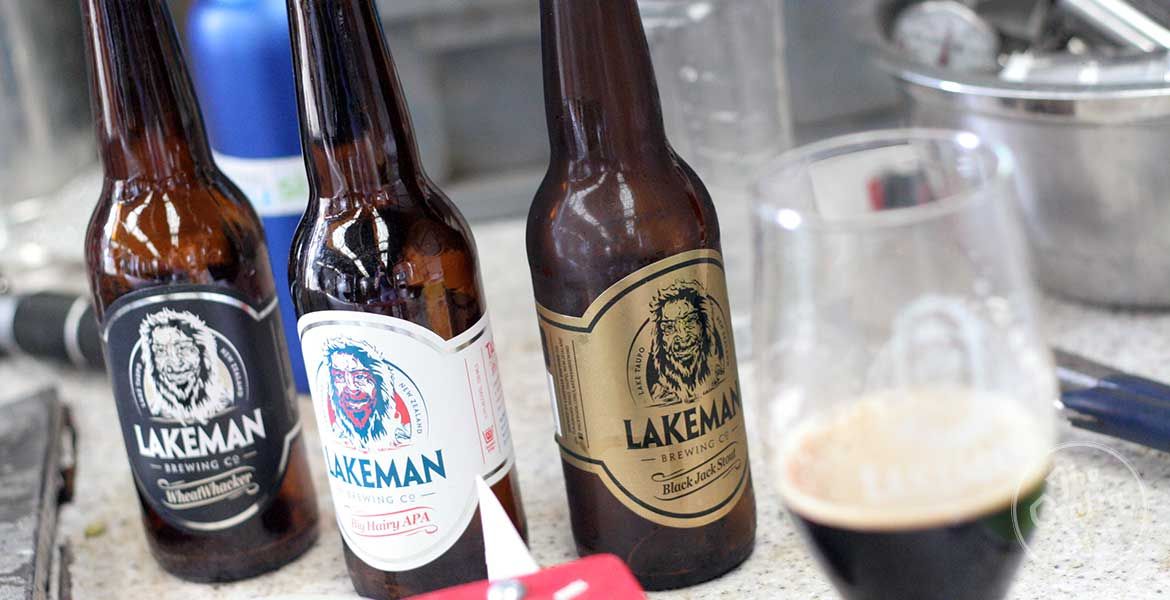
It goes by the name Lakeman and its owners, husband and wife James and Elissa Cooper, have been in possession of the brewery equipment – the original kit from Tuatara – for almost seven years. For most of that time it simply sat idle.
Says James: “We’d sold a farm in Australia and a mate gave me a bottle of Coopers and we thought, 'Wouldn’t it be good to own your own brewery?' so we came back here and bought one.
“We’d bought it with another guy and he was meant to be the brewer, but he went home to the dairy farm. The system sat here for four or five years and we thought, 'Well, we either give it a go or get rid of it.'
"So we said, 'If we can’t make a beer we can drink after the third brew, we’ll sell it'. After the fourth one, we got it.”
With the brewery operating at a functional level they reached out for guidance from Graeme Mahy, the well travelled Kiwi brewer and consultant who has a habit of leaving much-loved beers in his wake, whether from his time at Moa, Murray’s, 666 Brewing, Murray’s for a second time, or at the breweries he collaborates with overseas while on trips for international beer judging duties. It was one of these connections, by way of the USA, that is proving to be central to Lakeman.
“We sent some beer up to Hamilton to Graeme,” says James, “and he said it was a bit rough around the edges but if we wanted a hand he could help. So he came in and critiqued things, we bumbled along for a bit and now Adam’s come along. Graeme said I should employ him, and I could tell he was pretty talented, so we did and he’s added a whole new dimension.”
Adam is Adam Andescavage, Lakeman’s American head brewer. It is something of a surprise to find him all the way out here considering for the previous two years he was the head brewer at Oregon’s Pelican Pub and Brewery. Pelican is a serial award winner and, among some 300 awards collected over two decades, is currently the holder of the Champion Medium International Brewery trophy at the Australian International Beer Awards, a trophy they have held for two consecutive years.
Although a homebrewer since an age where it might not have been entirely legal in his home country, Adam was only drawn into commercial brewing at Pelican through a chance encounter.
“I’d travelled the world for a while,” he says, “and I went to Oregon to visit one of my brothers. He took me to a brewery and goes, 'You need to drink this beer. It’s the best I’ve had in my entire life.' I had a pint and went, 'Oh my god. I’m going to quit my professional life, what I’ve studied at University and paid hundreds of thousands of dollars for, and this is what I’m going to do for the rest of my life. But I have to work here.'
“I literally walked into the office at the brewery and said, 'I’d like a job.' And they kind of went, 'Yeah, OK, we’ll consider you.'
"I came back the next day and said, 'I’m dead serious, I want a job here.' and they said, 'OK, well you’re going to get all the shit work: start scrubbing tanks, cleaning kegs, do this, do that.'
"I was all over it. I just loved being around the brewery. The two head brewers at the time were Waylon [McAllister] and Whitney [Burnside] and they, I guess, saw my keenness and said, 'We’ll train you on this, see if you can pick it up, train you on that, see if you can pick it up,' and within a year I was the assistant head brewer. When they left I became the head brewer. That was pretty much all within a year.”
In total, he spent around three years at Pelican, two as head brewer plus the one working up to the role. During that time it grew quickly, from something a similar size to Lakeman’s approximately 200,000 litre annual capacity to a new state of the art brewery producing several million litres. That’s when he decided to take a break, came to New Zealand and decided not to leave.
“There were a couple of reasons why I came here,” says Adam. “One, this is the last working holiday visa I could get and I wanted to go somewhere great. Two, I want to learn about New Zealand hops. Coming from the US, New Zealand hops are pretty hard to get a hold of and, I would argue, some of the best in the world, so when they become available [at which point James intervenes claiming: “They never will!”] I’ll probably be one of the first there to say, 'I know how to use them.'
“The third thing is that New Zealand has a growing craft beer scene. whereas the US is peaking so it’s getting pretty hard. Eventually I’ll start my own brewery, maybe something a little bigger than this, but I want to see what it takes.
"This is a pretty small operation run essentially by me, James, Elissa and whoever else is around and it’s probably what I want to do in the US. In Portland, we had 400 breweries in a town of 600,000 people and they’re all this size or smaller. To me, why would you want to start a brewery in a town that has 600,000 people and 400 breweries? Why not go somewhere else and try to break into it?”
While having a brewer with experience at such a respected brewery is undoubtedly a big plus, Lakeman is no Pelican, nor does it wish to be. Where the Oregon brewery gleans much of its reputation for high quality interpretations of more orthodox beer styles, Lakeman flirts around the edges and in between.
“Coming from the US and a pretty popular brewery that brewed traditional styles where we didn’t have to guess,” says Adam, “I’m finding in New Zealand and Australia that just because the brewer says, 'This is the style of beer I’m making,' it doesn’t mean that’s actually what it is.
“There are two ways I look at it: either you’re making it to the BA [Brewer’s Association] guidelines or you’re making it based on what you think it is. Typically, the more guideline you go the stricter the filter you go through to call it, say, a US IPA or English IPA. If you’re off the wall you can’t get into a fight about it.”
At Lakeman, Adam is evidently not looking for a fight.
“By definition [Lakeman’s Wheatwhacker] qualifies as a wheat beer, but it doesn’t have the right yeast, or the esters or the phenols that come from the yeast [not to mention the addition of juniper and lemon]. It’s the same thing with the Black Jack stout. It’s an American stout, but it’s infused with raisin, rum and oak staves. The bottom line is it’s still a US stout but it’s got other stuff to make it unique. It’s still in the guidelines, but it's creative within the guidelines.”
That would seem a decent way of describing Lakeman’s beers. They have a pilsner that, unusually, is not dry hopped like most New Zealand pilsners yet retains big hop aroma and flavours, two pale ales made with New Zealand hops and one with American, the Hairy Hop which is a slightly English IPA, a red ale named Lahar and, just because no one else was really doing it, the Badonkadonk double black IPA.
Says James: “At the end of the day, I suppose it’s a bit of a shotgun approach and we just do what we want to do, but we really want to push the New Zealand side of it because lots of people seem to be chasing the US side of things. Being brewed on a farm, it would be nice to turn people around to that whole New Zealand Sauvignon Blanc story, but with hops.”
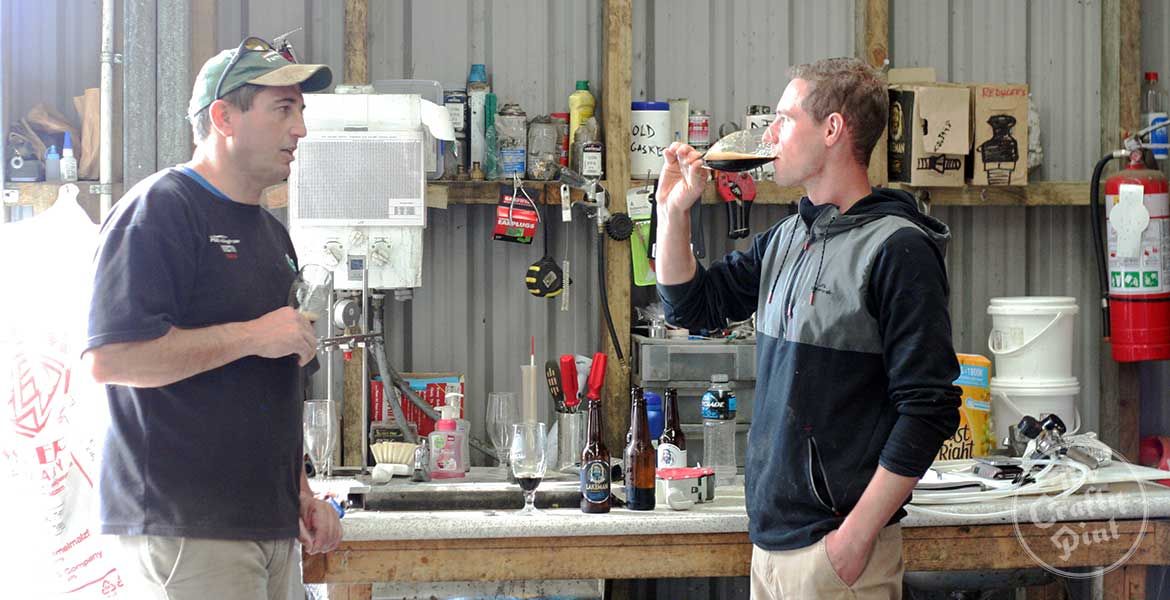
Lakeman does have an eye on exporting to help showcase what they’re doing with New Zealand hops in particular, but first there is the local market to contend with.
“We struggled in Taupo,” says James, “we really did. It’s a small town, the population’s only 27,000 – although it doubles over summer – and we don’t sell a lot of kegs here [at the time of visiting, the number of places you could get Lakeman on tap in Taupo was approximately two].
“It’s been frustrating. A year ago it was just me and Elissa pushing wheelbarrows around, but we basically had to get our shit together. We didn’t want anything to go out until we got the quality right, but now we’ve got a brewer and another part timer. We’ve still got a long way to go but things are growing.
“It’s hard when you’re not in the town but it just means we have to shout that bit louder and go a bit harder to get in the door. The guys in Wellington are loyal to their own breweries which makes it just a little bit harder for us guys out in the provinces. It’s no good bitching and moaning, you just have to fight harder and get up them a bit. We want to be smart and cheeky about it – without being Wicked Campers – because we are what we are, just lads from the country, and I’m pretty sure there are plenty of others like us too.”
Country or not, there’s certainly a lot to like – just as there is at so many other small breweries across the central North Island.
There are now so many of them in the regions that they seem to be changing the whole beer landscape, one town at a time. There will, of course, be challenges and barriers to their growth. New Zealand’s population, while generally enthusiastic about local beer, remains relatively small. Tap contracts, a hangover from another era which cannot seemingly be shaken off, continue to lock many small breweries out of their most convenient local markets. And, as more craft breweries are inevitably bought into the fold of the keepers of those contracts, the dynamics of the market will surely shift again.
But each brewer seems to have its own answer. When there was nowhere in Hamilton to worship good beer, Good George created a church and launched an empire. The brewers of Hawkes Bay keep things close to home by pitching to their population’s love of local produce. In the holiday haven of the Coromandel Peninsula, you can pitch a tent then walk a few metres across the grass to grab a case of freshly canned beer. In Martinborough, people now toast a tough day on the wine trail by kicking back at the local brewery.
Taking a Tiki Tour of these regions only serves to confirm that, while the big cities will inevitably hog the headlines, a great part of New Zealand’s craft beer story is being written in the provinces.
About the author: Nick Oscilowski lives on the South Coast of New South Wales and writes about beer. He has nothing to complain about.
Sadly, this article brings Nick's four-part Tiki Tour through New Zealand's North Island to a close. If you missed the other features, you can find them here:









